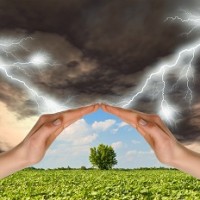Common Natural Disasters

15 Most Common Natural Disasters Known to Man
While not a daily occurrence, there are some natural disasters that strike more often than others. These are the 15 most common natural disasters that occur around the world.
A wide spread severe storm, born on the ocean or the Gulf of Mexico. The storm features an eye at its center and can cause damage on a massive scale. The most destructive forces with a hurricane include high wind speeds and storm surge with flooding.
Supercell thunderstorms may produce a violent rotating column of air known as a tornado. These storms are very common in areas of the United States with damage ranging from blown around furniture to wiping out entire towns.
Not always giant waves crashing to shore, a tsunami tends to be a succession of waves reaching the shore within a space of minutes to several hours. Not all tsunamis are destructive while others are capable of wiping away entire villages. Tsunamis occur after a large displacement of water on the ocean floor, typically caused by mega-thrust earthquakes.
- Typhoons
Typhoons are a large, ocean based storm that forms in the western part of the North Pacific Ocean. There is no difference between a typhoon and a hurricane, both are severe cyclonic storms, it’s simply where they form that changes the name.
Formed as either a mountain or a caldera, volcanoes erupt hot molten lava and ash into the air at incredible speeds. Depending on the type of volcano, they can produce a pyroclastic flow – superheated rocks and steam that destroys everything in its path on contact.
- Avalanche
A sudden displacement of hundreds of tons of snow and sometimes rocks, breaking free from a mountain side and sliding down the slopes of the mountain. An avalanche may be caused by the weight of the snow at weak points breaking free, or it can be caused by volcanic eruptions or earthquakes.
- Blizzard
A fierce winter storm carrying very high winds (35mph and up), low to zero visibility and very cold temperatures for a sustained period of at least 3 hours. The storm produces blowing snow and the difference between a blizzard and snowstorm is the strength of the wind, not the snowfall amount.
A long period of little to no rainfall and very little ground water affecting an area that causes widespread damage on an economic and environmental level. Droughts can last as little as 2 weeks to several years causing enormous hardship on people in the area.
The sudden violent shaking of the Earth that may cause buildings and other structures to topple due to the immense pressure. Earthquakes occur when the pressure of tectonic plates moving against each other releases, causing the ground the move.
10. Heat Wave
A prolonged period of extremely hot weather, sometimes accompanied by high humidity that is warmer than the usual temperatures for the region. A severe heat wave can cause extensive crop damage and failure, water shortage and deaths by hyperthermia.
11. Flood
Floods are an overflow of water typically from large lakes or rivers breaching their banks and inundating the surrounding landscape with water. A flood may also occur when a breach in a dam or levee occurs, as the case with New Orleans during Hurricane Katrina.
12. Landslide
A landslide occurs when a weak area of the ground gives way allowing gravity to take over and the land to slide down a slope, cliff or hill. Landslides may occur both on land and in the water, which can trigger a tsunami.
13. Sandstorm
A sandstorm occurs when a high wind event occurs over a mostly sandy area, typically desert regions like Nevada or the Middle East for an example. The high wind speed picks up the top layers of sand and carries it for miles in every direction, effectively limiting visibility and making it very difficult to breathe.
14. Wildfire
A wildfire is an uncontrolled fire occurring in a vegetation area such as a forest, brush or prairies. They are common in areas such as Australia and California due to their high temperatures and dry climate.
15. Impact of Meteor or Asteroid
Earth is impacted every year by meteors or portions of comets; however, a large asteroid is capable of causing all life on Earth to cease. The impact can cause a larger than nuclear level explosion, causing the sky to literally burn and dust to shut out the sun for years.
